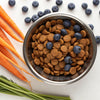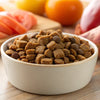Enhancing Your Dog's Kibble: What Can Be Added to Dry Dog Food
- Houndsy
Table of Contents
- Introduction
- Understanding Dry Dog Food
- Nutritional Benefits of Adding Fresh Foods
- What Can Be Added to Dry Dog Food?
- Practical Tips for Adding to Kibble
- Conclusion
Introduction
Did you know that over 60% of dog owners choose kibble as their pet's primary food source? While this convenient option is popular, it can sometimes lack the variety and nutrition your furry friend craves. We’ve all seen our dogs turn their noses up at their food, leaving us wondering how we can make mealtime more exciting and nutritious. So, what can be added to dry dog food to elevate your dog’s dining experience?
In this blog post, we’ll dive into various nutrient-rich and appetizing additions that can transform plain kibble into a gourmet meal. We’ll explore the nutritional benefits of these ingredients, how they can enhance your dog's diet, and practical tips for incorporating them into your dog’s feeding routine. By the end, you’ll have a wealth of ideas to keep your dog engaged and satisfied during mealtime.
At Houndsy, we believe in simplifying and elevating the dog-feeding experience. Our flagship product, the Houndsy Kibble Dispenser, is designed to provide a convenient and stylish way to serve your dog's food while maintaining precise portion control. Let’s discover how to enhance your dog’s meals while keeping mealtime easy and enjoyable.
Understanding Dry Dog Food
Before we explore what to add to dry dog food, it's essential to understand the role kibble plays in your dog's diet. Dry dog food is formulated to provide a complete and balanced diet, containing the necessary nutrients for dogs. However, it is often processed and can lack the variety that fresh foods offer.
The Limitations of Kibble
While kibble provides convenience, there are some downsides to consider:
- Processing: Most kibble undergoes high-temperature processing, which can strip away some nutrients.
- High Carbohydrate Content: Kibble is often high in carbohydrates, which dogs do not need in large quantities.
- Lack of Freshness: Kibble lacks the freshness and taste that many fresh foods provide, which can lead to less excitement at mealtime.
By understanding these limitations, you can make informed decisions about what to add to your dog's dry food to enhance their diet and overall enjoyment.
Nutritional Benefits of Adding Fresh Foods
Adding fresh foods to your dog’s kibble can introduce new flavors and textures while providing additional nutrients. Here are some key benefits:
- Increased Nutritional Value: Fresh foods often contain vitamins, minerals, and antioxidants that enhance your dog’s overall health.
- Improved Palatability: Fresh ingredients can make meals more appealing, encouraging picky eaters to enjoy their food.
- Better Digestion: Many fresh foods contain fiber, which can aid in digestion and keep your dog’s gut healthy.
Now, let’s explore some specific foods that can be added to dry dog food.
What Can Be Added to Dry Dog Food?
Here are several nutritious and tasty options to enhance your dog’s kibble.
1. Eggs: Protein Powerhouse
Eggs are a fantastic source of protein and essential amino acids. You can serve them scrambled, boiled, or even raw (if you’re comfortable with the risks). Just be sure to introduce eggs gradually to avoid digestive upset.
- Benefits: Rich in vitamins and minerals, eggs support muscle growth and repair.
- Serving Size: One egg per day for larger dogs; smaller dogs can have half an egg.
2. Lean Meats: Flavor and Protein
Adding cooked chicken, turkey, or lean beef can boost your dog’s protein intake significantly. Ensure all bones and skin are removed, and avoid seasoning with garlic or onion, which are toxic to dogs.
- Benefits: Provides high-quality protein and essential nutrients.
- Serving Size: About 1 ounce of meat per 10 pounds of body weight.
3. Fish: Omega-3 Fatty Acids
Fish, such as salmon or sardines (packed in water), are excellent sources of omega-3 fatty acids, promoting healthy skin and coat.
- Benefits: Supports cardiovascular health and reduces inflammation.
- Serving Size: A small portion, about 1 ounce per 10 pounds of body weight.
4. Dairy Products: Calcium and Probiotics
Plain, unsweetened yogurt or cottage cheese can be a tasty addition. These dairy products are rich in calcium and probiotics, aiding digestion.
- Benefits: Good for bone health and digestive health.
- Serving Size: 1 tablespoon of yogurt or cottage cheese for small dogs, up to 1/4 cup for larger breeds.
5. Canned Pumpkin: Digestive Aid
Plain canned pumpkin (not pumpkin pie filling) is a fantastic source of fiber and helps regulate digestion.
- Benefits: Soothes an upset stomach and prevents constipation.
- Serving Size: 1 teaspoon per 10 pounds of body weight.
6. Vegetables: Nutrient Boost
Cooked or pureed vegetables like carrots, green beans, or sweet potatoes can add fiber and nutrients to your dog’s diet.
- Benefits: Boosts overall health and provides essential vitamins.
- Serving Size: 1 tablespoon of pureed vegetables per 10 pounds of body weight.
7. Fruits: Sweet Treats
Fruits such as blueberries, apples (without seeds), and bananas can be added as a sweet treat. However, be mindful of their sugar content.
- Benefits: Rich in antioxidants and vitamins.
- Serving Size: A few small pieces or slices, depending on the fruit.
8. Healthy Fats: Omega Boost
Adding a drizzle of olive oil or flaxseed oil can provide healthy fats that improve coat health and support joint function.
- Benefits: Supports skin and coat health.
- Serving Size: 1 teaspoon for small dogs, 1 tablespoon for larger dogs.
9. Homemade Broth: Flavor Enhancer
A splash of homemade chicken or beef broth can add moisture and flavor to dry kibble, making it more enticing.
- Benefits: Increases hydration and adds flavor.
- Serving Size: A few tablespoons mixed in with the kibble.
10. Commercial Food Toppers: Convenience
For those busy days, consider commercial dog food toppers that are designed to complement kibble. Just be sure to choose high-quality options without fillers or artificial ingredients.
- Benefits: Provides additional flavors and nutrients without the need for preparation.
- Serving Size: Follow the serving suggestions on the package.
Practical Tips for Adding to Kibble
Now that we've explored various additives, here are some practical tips to ensure you're enhancing your dog’s diet effectively:
- Introduce Gradually: When adding new ingredients, start with small amounts to prevent digestive upset.
- Balance is Key: Make sure that the majority of your dog’s diet still comes from their high-quality kibble. Aim for about 10% of their daily caloric intake to come from fresh foods.
- Consult Your Vet: If you're unsure about which additions are best for your dog, consult with your veterinarian to tailor your approach based on their specific needs.
Conclusion
Incorporating fresh foods into your dog’s dry kibble can significantly enhance their diet, making mealtime more enjoyable and nutritious. With options ranging from protein-rich meats and eggs to fiber-packed vegetables and fruits, the possibilities are endless.
As we strive to simplify and elevate the dog-feeding experience at Houndsy, we encourage you to explore these additions and see how they transform your dog's meals. And remember, the Houndsy Kibble Dispenser can help make serving these delicious meals a breeze—check it out here.
FAQ
1. Can I feed my dog raw eggs?
Yes, but be cautious of the risks of salmonella. Cooking eggs can reduce this risk.
2. How often should I add fresh foods to my dog’s kibble?
You can add fresh foods daily, but ensure they only make up about 10% of your dog’s total diet.
3. Are all fruits and vegetables safe for dogs?
No, some fruits and vegetables can be toxic to dogs (such as grapes and onions). Always research or consult your vet.
4. How can I tell if my dog is allergic to a new food?
Monitor your dog for signs of allergies, such as itching, gastrointestinal upset, or changes in behavior after introducing new foods. If you notice any adverse reactions, stop feeding that item and consult your vet.
5. Is it okay to mix wet and dry dog food?
Yes, mixing wet and dry food can provide variety and enhance the flavor, but balance is essential to maintain nutritional adequacy.
Feel free to reach out with any additional questions, and let’s make mealtime fun and nutritious for our furry friends!












